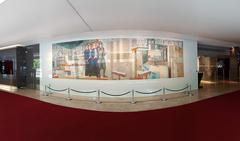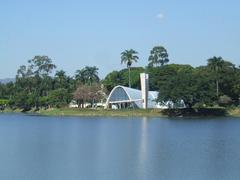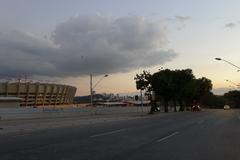Avenida João Pinheiro Belo Horizonte: Visiting Hours, Tickets, and Historical Sites Guide
Date: 04/07/2025
Introduction
Avenida João Pinheiro is an iconic artery in the heart of Belo Horizonte, Brazil. Famed for its historical significance, architectural diversity, and vibrant cultural scene, the avenue serves as both a living chronicle of the city’s origins and an active corridor for art, events, and urban life. Stretching from Praça Afonso Arinos to Praça da Liberdade in the Boa Viagem neighborhood, it offers visitors a window into Belo Horizonte’s planned beginnings as one of Brazil’s first modern capitals, founded in the late 19th century. Named after João Pinheiro da Silva, a notable governor of Minas Gerais, the avenue exemplifies ideals of order, progress, and modernization (WebQuarto’s João Pinheiro guide).
Blending neoclassical, eclectic, and modernist architecture with green spaces and public plazas, Avenida João Pinheiro is pedestrian-friendly and home to important institutions such as Fundação João Pinheiro and Museu Mineiro. Dynamic public art, community events, and proximity to attractions like Praça da Liberdade underscore its appeal for history buffs, architecture lovers, and cultural explorers alike (Adventure Backpack; Portal Belo Horizonte).
This guide delivers comprehensive details on visiting hours, ticketing, transportation, accessibility, sightseeing tips, and cultural highlights to help you plan a rewarding visit.
Table of Contents
- Historical Context and Urban Evolution
- Architectural Landmarks and Styles
- Cultural Institutions and Artistic Expression
- Visiting Hours, Tickets, and Accessibility
- Transportation and Getting There
- Safety and Traveler Recommendations
- Nearby Attractions
- FAQs
- Visuals and Media Resources
- Conclusion
- Sources
Historical Context and Urban Evolution
Belo Horizonte was conceived in the 1890s as Brazil’s first planned capital, designed with a rationalist grid inspired by Washington, D.C. Avenida João Pinheiro was integral to this plan, running between the administrative center and growing residential districts. Its establishment in the privileged central zone—reserved for government and elite residences—reflected the city’s aspirations for order and modernity.
Over the decades, the avenue witnessed urban expansion, the construction of landmark buildings, and the emergence of a lively civic and cultural life. Its architecture and layout remain emblematic of the city’s evolution from planned capital to a dynamic urban hub (WebQuarto’s João Pinheiro guide).
Architectural Landmarks and Styles
Eclectic and Early 20th Century Public Buildings
Avenida João Pinheiro is adorned with early 20th-century architecture, notably the Palácio da Liberdade, which combines neoclassical and art nouveau styles. The avenue’s grandeur is further enriched by government buildings, schools, and cultural institutions, each reflecting the eclectic tastes of their era.
Modernist Influences
Mid-century modernist architecture left a distinct mark on the avenue. Influences from Oscar Niemeyer and contemporaries can be seen in clean lines and innovative forms, harmoniously integrated with public art—a testament to Belo Horizonte’s embrace of architectural modernism (Adventure Backpack).
Green Spaces and Urban Design
Tree-lined sidewalks, landscaped medians, and small plazas punctuate the avenue, providing aesthetic and environmental relief. These features illustrate the original vision of blending built and natural environments for public enjoyment.
Cultural Institutions and Artistic Expression
Museums and Cultural Centers
The avenue hosts significant cultural venues, including the Museu Mineiro, home to an extensive collection of regional art and artifacts. Its proximity to the Circuito Liberdade—a network of museums and galleries—bolsters its reputation as a cultural hotspot (Adventure Backpack).
Public Art and Urban Murals
Avenida João Pinheiro and its surroundings are alive with public art, from murals to sculptures. Local artists use these spaces to celebrate the city’s identity and social movements, making the avenue a canvas for creative expression.
Festivals and Events
Throughout the year, the avenue transforms into a stage for festivals, open-air concerts, and community gatherings that showcase Belo Horizonte’s musical, culinary, and artistic traditions.
Visiting Hours, Tickets, and Accessibility
- Avenida João Pinheiro: Publicly accessible 24/7.
- Key Institutions:
- Fundação João Pinheiro: Mon–Fri, 9:00–18:00
- Museu Mineiro: Tue–Sun, 9:00–17:00
- Palácio da Liberdade: Guided tours, check official schedule
- Ponto Cultural CDL: Tue–Sat, 10:00–16:00 (guided tours at 10:30 and 14:00)
- Admission:
- Walking the avenue is free.
- Museums charge R$10 on average; many offer free entry on certain days.
- Guided tours may require advance booking (Ponto Cultural CDL).
- Accessibility:
- Sidewalks and most public buildings are wheelchair accessible.
- Some historic sites have limited access due to preservation status.
- Travel Tips:
- Weekdays are lively; weekends are quieter and ideal for leisure walks.
- Early mornings and late afternoons offer the best light for photography.
Transportation and Getting There
- Bus: Lines 2104, 4034, 5102, 5104, and 8001A stop along the avenue.
- Metro: Estação Carlos Prates (approx. 25 minutes’ walk).
- Train: Estação Ferroviária de Belo Horizonte serves regional travelers.
- Taxi/Ride-hailing: Uber, 99, and Cabify are reliable; fares to the city center typically R$10–R$30.
- Driving: Parking is limited; private lots charge R$10–R$25/hour.
- Walking: The avenue’s central location and tree-lined sidewalks invite strolls between attractions.
For real-time transit updates, use the Moovit app.
Safety and Traveler Recommendations
- Daytime: Generally safe due to frequent police and Municipal Guard presence. Remain vigilant against pickpocketing in crowded areas.
- Nighttime: Foot traffic diminishes; avoid poorly lit or deserted areas after dark. Prefer taxis or ride-hailing services.
- Solo and Female Travelers: Exercise caution at night. Share itineraries and avoid isolated routes.
- Emergencies: Dial 190 (police), 192 (medical), or 193 (fire). Municipal Guards are stationed near main attractions (HowSafe.net).
Nearby Attractions
- Praça da Liberdade: Historic square with museums and government buildings.
- Palácio da Liberdade: Former state government palace with guided tours.
- Boa Viagem Neighborhood: Cafés, restaurants, and cultural venues.
- Praça Afonso Arinos: Southern gateway to the avenue’s attractions.
- Savassi District: Nightlife and dining hub.
- Parque Municipal Américo Renné Giannetti: Urban park with lakes and events.
- Mercado Central: Culinary destination for traditional Minas Gerais flavors.
FAQs
Q: What are the visiting hours for Avenida João Pinheiro and its attractions?
A: The avenue is open 24/7. Museums and cultural centers usually operate 9:00 or 10:00–17:00/18:00, Tuesday to Sunday.
Q: Are tickets required for entry?
A: Walking the avenue is free. Some museums charge around R$10, with free days available.
Q: Is the avenue accessible for people with disabilities?
A: Yes, most sidewalks and major attractions are accessible, though some historic buildings have limitations.
Q: What is the best time to visit?
A: May to September offers dry, mild weather. Early mornings and late afternoons provide optimal lighting and comfort.
Q: How do I get to Avenida João Pinheiro?
A: Use city buses, metro, taxis, or ride-hailing apps from the city center or airport. Walking is also convenient for nearby attractions.
Visuals and Media Resources
Explore high-quality images, interactive maps, and virtual tours of Avenida João Pinheiro and its landmarks via official tourism websites and the Ponto Cultural CDL. Use alt text such as “Avenida João Pinheiro historical sites” or “Palácio da Liberdade architecture” when sharing photos on social media.
Conclusion
Avenida João Pinheiro is much more than a thoroughfare—it’s a living symbol of Belo Horizonte’s historical legacy, architectural beauty, and cultural vitality. With its blend of heritage buildings, lush green spaces, vibrant street art, and year-round events, the avenue offers an immersive experience for all visitors. Plan your visit by checking institutional schedules, considering guided tours, and utilizing resources like the Audiala app for up-to-date information and personalized recommendations. Stay connected through official tourism websites and social media to make the most of your journey through this remarkable avenue.
Sources
- This guide draws upon information and recommendations from:




